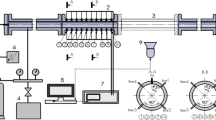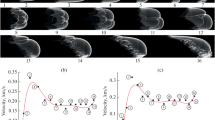Abstract
Measurements of turbulent burning velocities in fan-stirred explosion bombs show an initial linear increase with the fan speed and RMS turbulent velocity. The line then bends over to form a plateau of high values around the maximum attainable burning velocity. A further increase in fan speed leads to the eventual complete quenching of the flame due to increasing localised extinctions because of the flame stretch rate. The greater the Markstein number, the more readily does flame quenching occur. Flame propagation along a duct closed at one end, with and without baffles to increase the turbulence, is subjected to a one-dimensional analysis. The flame, initiated at the closed end of the long duct, accelerates by the turbulent feedback mechanism, creating a shock wave ahead of it, until the maximum turbulent burning velocity for the mixture is attained. With the confining walls, the mixture is compressed between the flame and the shock plane up to the point where it might autoignite. This can be followed by a deflagration to detonation transition. The maximum shock intensity occurs with the maximum attainable turbulent burning velocity, and this defines the limit for autoignition of the mixture. For more reactive mixtures, autoignition can occur at turbulent burning velocities that are less than the maximum attainable one. Autoignition can be followed by quasi-detonation or fully developed detonation. The stability of ensuing detonations is discussed, along with the conditions that may lead to their extinction.
Similar content being viewed by others
References
G. Ciccarellia and S. Dorofeev, “Flame Acceleration and Transition to Detonation in Ducts,” Prog. Energ. Combust. Sci. 34, 499–550 (2008).
J. Chao and J. H. S. Lee, “The Propagation Mechanism of High Speed Turbulent Deflagrations,” Shock Waves 12, 277–289 (2003).
R. P. Lindstedt and H. J. Michels, “Deflagration to Detonation Transitions and Strong Deflagrations in Alkane and Alkene Air Mixtures,” Combust. Flame 76, 169–181 (1989).
D. Bradley, M. Lawes, and K. Liu, “Turbulent Flame Speeds in Ducts and the Deflagration/Detonation Transition,” Combust. Flame 154, 96–108 (2008).
R. G. Abdel-Gayed, D. Bradley, M. N. Hamid, and M. Lawes, “Lewis Number Effects on Turbulent Burning Velocity,” in Twentieth Symp. (Int.) on Combustion (The Combustion Inst. Pittsburgh, 1985), pp. 505–512.
Ya. B. ’Zeldovich, V. B. Librovich, G. M. Makhviladze, and G. I. Sivashinsk, “On the Development of Detonation in Non-Uniformly Preheated Gas,” Astronautica Acta 15, 313–321 (1970).
P. A. Urtiew and A. K. Oppenheim, “Experimental Observations of the Transition to Detonation in an Explosive Gas,” Proc. Roy. Soc. London A295, 13–28 (1966).
V. P. Karpov and E. S. Severin, “Effects of Molecular-Transport Coefficients on the Rate of Turbulent Combustion,” Fiz. Goreniya Vzryva 16(1), 45–51 (1980) [Combust., Explos., Shock Waves 16 (1), 41–46 (1980)].
D. Bradley, M. Lawes, K. Liu, and R. Woolley, “The Quenching of Premixed Turbulent Flames of Iso-Octane, Methane and Hydrogen at High Pressures,” Proc. Combust. Inst. 31, 1393–1400 (2007).
D. Bradley, P. H. Gaskell, X. J. Gu, and A. Sedaghat, “Premixed Flame Modelling: Factors Influencing the Turbulent Heat Release Rate Source Term and the Turbulent Burning Velocity,” Combust. Flame 143, 227–245 (2005).
D. Bradley, M. Lawes, and M. S. Mansour, “Correlation of Turbulent Burning Velocities of Ethanol-Air, Measured in a Fan-Stirred Bomb up to 1.2 MPa,” Combust. Flame 158, 123–138 (2011).
D. Bradley, M. Lawes, and M. S. Mansour, “Measurement of Turbulent Burning Velocities in Implosions at High Pressures,” Proc. Combust. Inst. 33, 1269–1275 (2011).
D. Bradley, “Autoignitions and Detonations in Engines and Ducts,” Phil. Trans. Roy. Soc. A A370, 389–714 (2012).
D. Bradley and G. T. Kalghatgi, “Influence of Autoignition Delay Time Characteristics of Different Fuels on Pressure Waves and Knock in Reciprocating Engines,” Combust. Flame 156, 2307–2318 (2009).
A. E. Lutz, R. J. Kee, J. A. Miller, H. A. Dwyer, and A. K. Oppenheim, “Dynamic Effects of Autoignition Centers for Hydrogen and C1,2-Hydrocarbon Fuels,” Proc. Combust. Inst. 22, 1683–1693 (1988).
X. J. Gu, D. R. Emerson, and D. Bradley, “Modes of Reaction Front Propagation from Hot Spots,” Combust. Flame 133, 63–74 (2003).
D. Bradley, C. Morley, X. J. Gu, and D. R. Emerson, “Amplified Pressure Waves during Autoignition: Relevance to CAI Engines,” SAE Paper No. 2002-01-2868.
D. Bradley, X. J. Gu, and D. R. Emerson, “Modes of Reaction Front Propagation from Hot Spots in Flammable Gaseous Premixtures,” in Proc. Fourth Int. Seminar on Fire and Explosion Hazards 2004, Ed. by D. Bradley, D. Drysdale, and V. Malkov (FireSERT, University of Ulster, 2004), pp. 819–828.
E. G. Oran and V. N. Gamezo, “Origins of the Deflagration-to-Detonation Transition in Gas-Phase Combustion,” Combust. Flame 148, 4–47 (2007).
M. I. Radulescu, G. J. Sharpe, C. K. Law, and J. H. S. Lee, “The Hydrodynamic Structure of Unstable Cellular Detonations,” J. Fluid Mech. 580, 31–81 (2007).
V. V. Voevodsky and R. I. Soloukhin, “On the Mechanism and Explosion Limits of Hydrogen-Oxygen Chain Self-Ignition in Shock Waves,” in Tenth Symp. (Int.) on Combustion (The Combustion Inst., Pittsburgh, 1965), pp. 279–283.
J. W. Meyer and A. K. Oppenheim, “On the Shock-Induced Ignition of Explosive Gases,” in Thirteenth Symp. (Int.) on Combustion (1971), pp. 1153–1164.
M. I. Radulescu, Hoi Dick Ng, J. H. S. Lee, and B. Varatharajan, “The Effect of Argon Dilution on the Stability of Acetylene/Oxygen Detonations,” Proc. Combust. Inst. 29, 2825–2831 (2002).
M. Short and G. J. Sharpe, “Pulsating Instability of Detonations with a Two-Step Chain-Branching Reaction Model: Theory and Numerics,” Combust. Theory Modelling 7, 401–416 (2003).
Z. Liang, R. Browne, R. Deiterding, and J. E. Shepherd, “Detonation Front Structure and the Competition for Radicals,” Proc. Combust. Inst. 31, 2445–2453 (2007).
J. M. Austin, F. Pintgen, and J. E. Shepherd, “Reaction Zones in Highly Unstable Detonations,” Proc. Combust. Inst. 30, 1849–1857 (2005).
J. E. Shepherd, “Detonation in Gases,” Proc. Combust. Inst. 32, 83–98 (2009).
V. N. Gamezo, D. Desbordes, and E. S. Oran, “Formation and Evolution of Two-Dimensional Cellular Detonations,” Combust. Flame 116, 154–165 (1999).
M. I. Radulescu and J. H. S. Lee, “The Failure Mechanism of Gaseous Detonations: Experiments in Porous Wall Tubes,” Combust. Flame 131, 29–46 (2002).
D. A. Kessler, V. N. Gamezo, and E. S. Oran, “Gas-Phase Detonation Propagation in Composition Gradients,” Phil. Trans. Roy. Soc. A A370, 567–596 (2012).
The Buncefield Incident, 11 December 2005. The final Report of the Major Incident Investigation Board, Vols. 1 and 2, (Buncefield Major Incident Investigation Board, 2008); Crown copyright, http://www.buncefieldinvestigation.gov.uk.
D. Bradley, G. A. Chamberlain, and D. D. Drysdale, “Large Vapour Cloud Explosions, with Particular Reference to that at Buncefield,” Phil. Trans. Roy. Soc. A A370, 544–566 (2012).
Author information
Authors and Affiliations
Corresponding author
Additional information
Original Russian Text © D. Bradley, M. Lawes, M. Mansour.
__________
Translated from Fizika Goreniya i Vzryva, Vol. 48, No. 5, pp. 39–49, September–October, 2012.
Rights and permissions
About this article
Cite this article
Bradley, D., Lawes, M. & Mansour, M. Turbulent deflagrations, autoignitions, and detonations. Combust Explos Shock Waves 48, 526–535 (2012). https://doi.org/10.1134/S0010508212050048
Received:
Published:
Issue Date:
DOI: https://doi.org/10.1134/S0010508212050048




